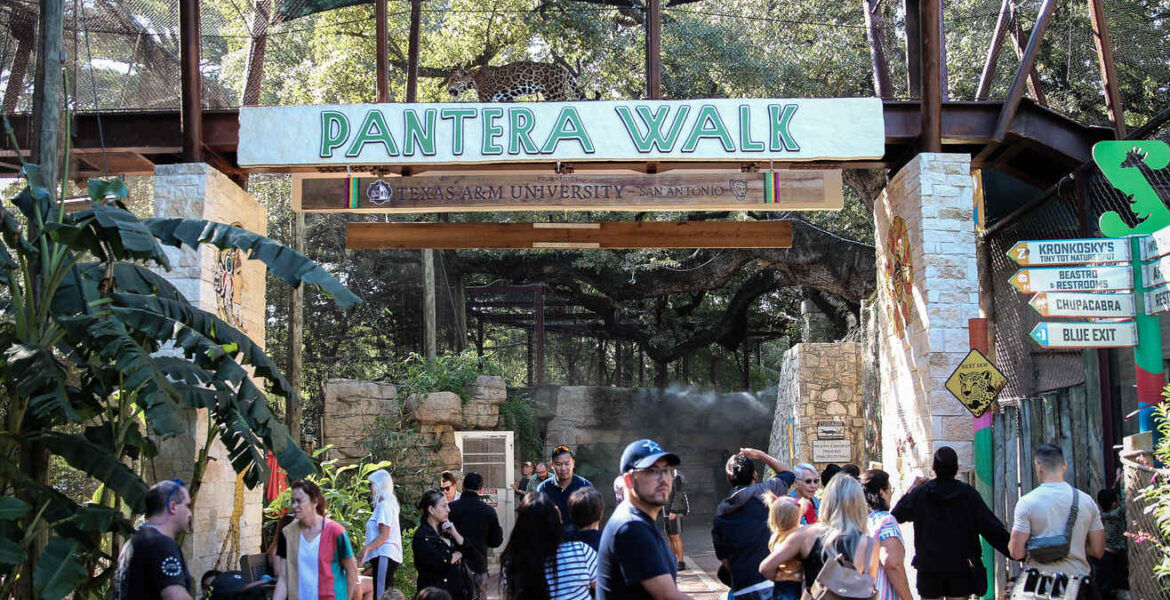Attendees from Texas A&M University-San Antonio viewed a university-sponsored jaguar habitat, received free swag and learned more about A&M-San Antonio on Nov. 4 at the San Antonio Zoo.
Zoo Day allowed visitors affiliated with A&M-San Antonio to buy tickets for $8 for that day only. However, they can get a 20% discount on general admission year-round.
“It’s to create an opportunity for our students, faculty, staff and alumni to enjoy the San Antonio Zoo at a heavily reduced cost,” said Jesse Pisors, vice president for university relations and advancement.
Family members participated, too.
“I came out here because I love animals,” Kaylee Delgado said as she took a break in the shade looking at the animals. “My brother is a student at A&M and he got us the tickets.”
A&M-San Antonio’s six-figure donation a win-win for university and zoo, official says
In 2021 A&M-San Antonio contributed $500,000 to the Pantera Walk jaguar exhibit and Project Selva for the welfare of the San Antonio Zoo, according to Pisors.
The partnership with the San Antonio Zoo is to promote the university while helping the zoo’s animals and projects.
The Pantera Walk is a neotropical exhibit that was unveiled Oct. 29, 2021. The new addition allows the jaguars to roam freely while visitors observe safely.
Contrary to A&M-San Antonio’s dark gray mascot, General the Jaguar, the jaguar at the San Antonio Zoo is coated with brown-ish yellow fur and decorated with black rosettes and spots.
The jaguar was seen taking a stroll across the skywalk into the enclosure to take a sip of water and quench its morning thirst during Zoo Day. The big cat stretched its legs and paced the exhibit.
The jaguar would glance at children screaming with excitement as the large spotted animal passed them by.
Pisors said A&M-San Antonio is the only university to ever partner with the zoo.
“As a zoo sponsor, we sponsor Pantera Walk. That’s where the jaguar enclosure is, and it is significant to us because we are the jaguars–but very importantly, it is a marketing and brand opportunity for the university,” Pisors said.
The partnership has helped establish new annual traditions for the university, such as the Jaguar Ring Ceremony: members of the graduating class place their rings in a box, which is put into the enclosure to be “blessed” by the jaguar B’alam.
The partnership also offers discounted tickets to A&M-San Antonio affiliates.
“1.2 million people a year walking through the zoo seeing our sign large and prominent … and a lot of them are young people, and that’s what we want to be thinking about our university,” Pisors said.
In front of Pantera Walk, a tabling event in association with Zoo Day offered free A&M-San Antonio T-shirts and bags to visitors.
Many guests enjoyed the free swag and were able to learn more about A&M-San Antonio.
“Yeah, I got the shirt. I now have something to change into,” Delgado said. “I thought it was cool that the university is associated with a jaguar and they have a sign and everything. It just looks so cool.”
University funding provides elbow room for jaguars, preservation of Amazon rainforest
The money the university gave in support of Pantera Walk allowed the jaguar more space in the enclosure and offered an environmentally friendly enrichment for the animals.
“It’s an attraction for people to see, gives the jaguars a little bit of exercise,” said a zoologist who did not disclose their name at the San Antonio Zoo.
Jaguars naturally live in high treetops in the jungle. The sky bridge along Pantera Walk helps simulate that environment for them.
The money also helps fund the Selva Project, a conservation project to preserve the Amazonian rainforest in the upper Amazon Basin in association with indigenous groups.
The San Antonio Zoo’s approach to the rainforest conservation project was inspired by conversations with indigenous people in northeastern Peru, according to the Selva Project website.
The initiative aims to preserve the rainforest while taking into account the viewpoints of the people who inhabit it.
A major issue facing Amazonia today is the absence of a consistent source of income and easy access to money.
Thus, Project Selva and the San Antonio Zoo established a partnership in Iquitos, Peru, where local artists and craftspeople can directly sell their art in the zoo’s gift stores.
Deadline to apply for zoo internships is Dec. 1
The zoo also offers internships and research opportunities in collaboration with A&M-San Antonio.
Spring 2024 applications opened Nov. 1 and close Dec. 1. The San Antonio Zoo provides internship opportunities focusing on animal care, education and business management.
Animal care internships involve the daily regimen of animals, animal behavior and record keeping. However, the internship is not research-based.
Non-animal care internships provide regular operations of the zoo’s divisions in marketing, graphics, education and revenue focusing on business management of the facility.
The San Antonio Zoo’s internships are not paid and housing is not provided.
Applications are required to have a cover letter, a letter of recommendation and a school transcript. Transcripts can be unofficial.
There is an application process fee of $79 upon acceptance into the program.
The applications are reviewed within two to three weeks after the deadline. The email address submitted on applications will be used to contact students if they are chosen for an interview.
For more information about Project Selva, the San Antonio Zoo and internship opportunities, visit https://sazoo.org/.







